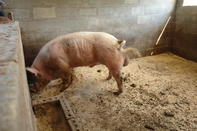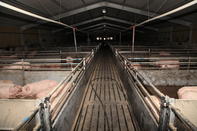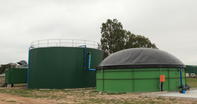While pig slurry is one of the biggest pollution threats on a pig farm, it can also be used to enhance farm profitability by using it as fertiliser, compost or to generate energy.

The first thing to consider even before starting a piggery, is how the slurry or manure will be collected. On a small farm where the pigs are allowed to roam outside, the manure should be removed regularly to prevent a build up of diseases and pollution.
The manure can be removed mechanically, with a spade. Mechanical removal is more difficult with intensive systems where pigs are produced in houses. Most of the modern houses are therefore designed to be slightly slanted allowing slurry to run-off into a storage pit or dam.
Government Legislation

Fertiliser
According to Danie Visser’s Modern Pig Production book, farmers usually separate the solids from the liquid and then use the liquid as fertiliser, by spreading it on certain crops or pastures. To prevent over-fertilisation and runoff, volumes applied are adjusted according to the nutritional requirements of the crop.
Soil samples are also taken annually to identify nutritional imbalances and rectify these before they get out of hand. Ask a soil scientist for advice before embarking on this, to help you identify the the nutritional content of the slurry and help you develop a fertilisation program.
Compost
The solids may be used as a source of nitrogen in compost. Allowing the compost to build up enough heat will help to destroy harmful pathogens.
The compost heap should be kept moist, but not wet, to accelerate decomposition and be turned regularly or aerated to ensure there is enough oxygen for the development of beneficial organisms.
The time it takes for the compost to be ready for use in a garden, will depend on climatic conditions, the composting ingredients and the way in which the compost is managed. Compost that is ready for use will have a earthy smell. If it smells bad, or putrid, there is something wrong with it.
Biogas

A bio-digester may be used to convert the slurry into biogas, which can be used for cooking, and to convert the biogas into thermal energy, for example to water and showers, and electricity, which may be used to reduce on-farm electricity costs or be sold back into the national energy grid.
High volumes of slurry are required to produce electricity, so farmers need to calculate the volume of slurry their pigs produce each month of the year to ensure there will be a continuous supply throughout the year.
Costs are driven up if a farmer decides to store the energy on the farm, through the use of batteries.
By Glenneis Kriel